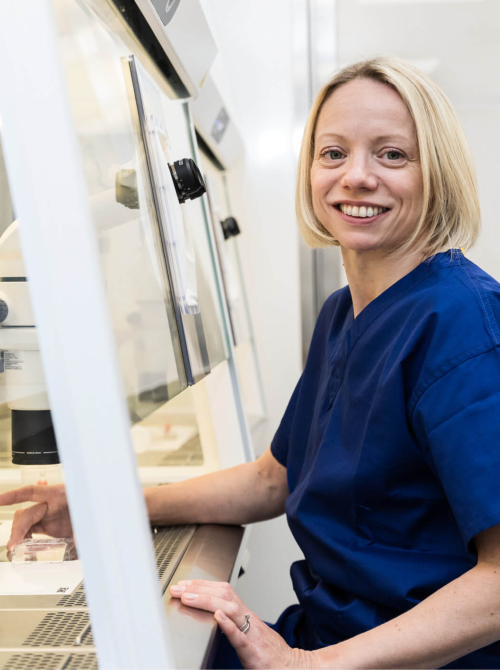What to Expect from a Typical IVF Cycle
Starting IVF is a big step, and we know it can feel overwhelming. One of the questions we hear most often is: How long will this take, and how will it fit into my life?
We’ve written this guide together, one of us from the clinical side and one from the lab, so you know not only what will happen at each stage, but also why it matters. IVF is very much a partnership between the medical team, the embryology lab, and you.
By Emma Whitney, director of embryology and genetics, and Dr Ed Coats, consultant gynaecologist and fertility specialist
Step 1: Your initial consultation
Your journey begins with a detailed conversation with your doctor. This is your time to share your medical history, any previous tests or treatments, and your hopes for building a family. We’ll talk about lifestyle factors, your goals, and whether IVF is the best route forward, or whether less invasive options may be worth considering first.
From the lab perspective, we use this consultation to start planning ahead. If your history suggests you might need ICSI, genetic testing (PGT-A), or specific sperm preparation, we build that into your plan early on. By the end of this meeting, you should leave feeling clear on your options and supported in your next steps.
Step 2: Your personalised treatment plan
Every treatment plan is bespoke. We create yours by combining your medical history, results, and family goals with the most appropriate treatment pathway. For some, this may be IUI or ovulation induction; for others, IVF gives the best chance of success.
Once your plan is agreed, our care coordination team will give you a personalised costing plan and talk through timings. Importantly, there is no waiting list at The Evewell — we’ll always try to work to your timeframe. From the lab side, this is also where we prepare for what may be needed: whether that’s planning for embryo freezing, genetic testing, or scheduling a fresh transfer.
Step 3: The nurse consultation
Next, you’ll meet one of our nurses for a detailed consultation that usually lasts up to 90 minutes. This is when your treatment becomes very real, as we take you through:
- Exactly what your medication protocol will look like
- How to take your injections, with time to practise and ask questions
- Possible side effects, and what to do if they occur
- Lifestyle advice to help optimise your results
- All required consent forms, explained page by page
Precision matters here. From the lab’s perspective, the exact timing of certain medications, especially the trigger injection, makes all the difference to egg maturity and fertilisation. By the end of this appointment, you should feel confident and ready to begin.
Step 4: Meeting the embryology team
This is your chance to meet the scientists who will be caring for your eggs, sperm, and embryos. For many patients, this meeting makes the process feel more personal. We’ll explain what happens in the lab after egg collection, how fertilisation is achieved (whether through IVF or ICSI), and how embryos are monitored using time-lapse incubators.
If PGT-A is part of your plan, we’ll also explain how the biopsy is taken, what the risks are, and how long results take. We want you to feel reassured that your embryos will be monitored continuously and cared for with precision and attention.
Step 5: The scanning phase
When your period starts, so does the active phase of your cycle. You’ll begin stimulation medication, designed to encourage your ovaries to grow multiple follicles. We’ll scan you regularly — usually every two or three days — to track follicle growth and hormone levels. Most patients have four to five scans across a two-week period.
Behind the scenes, the lab uses this information to prepare for your egg collection. The synchronisation between clinic and lab is critical: when your follicles look ready on scan, we’ll be ready to collect mature eggs and begin the fertilisation process.
Step 6: Egg collection
When your follicles are the right size, you’ll be given a trigger injection around 36 hours before egg collection. On the day, you’ll be under deep sedation, so you won’t feel anything. The procedure itself takes 20–30 minutes, and afterwards you’ll rest in a quiet room until you’re ready to go home. We’ll confirm how many eggs were collected and what happens next.
In the lab, we receive your eggs immediately. Depending on your plan, we’ll either mix them with sperm (IVF) or inject a single sperm into each mature egg (ICSI). Our focus is to support normal fertilisation while being as gentle as possible with your eggs and sperm.
Step 7: Fertilisation and early embryo development
The following day, we’ll call you with an update on fertilisation and how many of your eggs have successfully fertilised. From there, embryos grow in our time-lapse incubators, which allow us to monitor them continuously without disturbing them.
You may not hear from us every day, but rest assured, your embryos are being carefully observed. If you’re planning a fresh transfer, we aim to have a blastocyst ready by day 5. If your plan involves freezing or PGT-A, we’ll contact you around day 5–7 to explain progress and next steps.
Step 8: Deciding on fresh or frozen transfer
Not every patient will have a fresh transfer. If your hormone levels are stable, your lining looks good, and you have a suitable embryo, a fresh transfer may be recommended. In many cases, however, we advise freezing embryos and transferring them in a later cycle, especially if you are having PGT-A or if your body needs more time to recover.
From the lab perspective, embryos reach the blastocyst stage on day 5–7. At this point, we’ll either prepare the best quality embryo for transfer or vitrify (rapidly freeze) it for future use. If we are performing PGT-A, we take a small biopsy from the embryo before freezing. Results usually return in about two weeks.
Step 9: The embryo transfer
For a fresh transfer, you’ll start progesterone to prepare your uterus. The procedure itself is quick, usually no more than 15 minutes, and feels similar to a smear test. Most patients can resume normal activities straight after.
During the transfer, we’ll talk you through the embryo’s development and confirm which embryo is being transferred. If there are additional embryos suitable for freezing, we’ll explain your options for storing them for future use.
Step 10: Preparing for a frozen transfer
If you’re having a frozen transfer, this happens in a separate cycle. We can use a natural cycle, timed with your ovulation, or a medicated cycle, where we use hormones to prepare your uterus. The benefit of frozen transfer is flexibility; we can choose the best timing for your body.
In the lab, embryos are thawed using a highly precise process, and survival rates are very high with modern vitrification. We confirm the embryo has warmed successfully before proceeding with your transfer.
Step 11: The two-week wait
This stage can be the hardest emotionally. You may feel pressure to look for symptoms, but these are often unreliable. We encourage patients to focus on self-care, gentle activity, relaxation, and support from friends or family.
From our side, there’s nothing special you need to do beyond following your plan. Implantation is something we cannot control, and no amount of extra monitoring changes the outcome. If you are anxious or unsure, call us. We’d rather reassure you than leave you worrying.
Step 12: The pregnancy test and beyond
We usually recommend taking a home pregnancy test about 12 days after a day 5 transfer. Whatever the result, please contact us.
If it’s positive, we’ll continue supporting you with scans, blood tests, and medication until around 12 weeks. If it’s not successful, we’ll arrange a complimentary follow-up consultation to review what happened and plan next steps. From the lab side, we’ll review your embryos’ development alongside your clinical results, so we can learn as much as possible and improve the chances for your next cycle.
Understanding timing and work-life balance
A typical short protocol cycle lasts around two weeks of stimulation, with four to five morning scans. Egg collection is a day procedure, and embryo transfer is brief, so most patients can continue with their normal routines with only a few days of disruption.
Much of the work happens behind the scenes in the lab while you carry on with your life. This often surprises patients, IVF can feel intense, but there are only a handful of days when you need to be physically in the clinic.
Emotional support and counselling
IVF is as emotional as it is physical. That’s why we offer complimentary counselling with every egg collection cycle. Some patients use supportive counselling to help process feelings, while others choose implications counselling if they’re considering donor treatment or genetic testing.
We want you to feel supported not just medically, but emotionally too. Meeting the embryology team, seeing the care taken with your embryos, and knowing that your doctors and nurses are available for questions all help reduce anxiety and build confidence.
A note on fertility preservation
For some patients, egg or embryo freezing may be part of their IVF journey. If you hope to have children later or want to preserve options for siblings in the future, freezing can be a helpful tool.
Younger eggs usually have a higher chance of creating a healthy pregnancy, so preserving them earlier can give you more options. While it’s not a guarantee, it can bring peace of mind.
Tags
All Categories
Discover more
Find out more
Frequently asked questions
Around 10–12 days, but always individualised.
Most scans are in the morning, egg collection is a day procedure, and transfer is quick. Many patients continue working through treatment.
No. You’ll hear after fertilisation, then around day 5–7, or sooner if there are important updates.
Biopsies are taken on days 5–7, and results are usually available about two weeks later.





